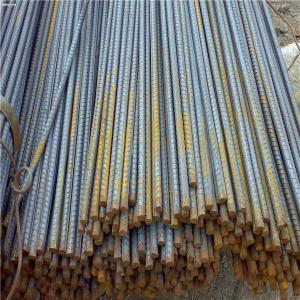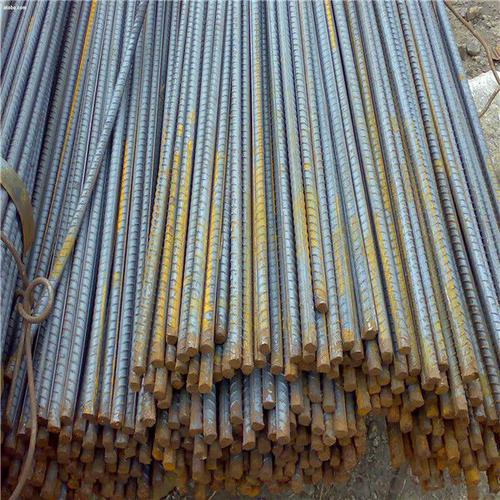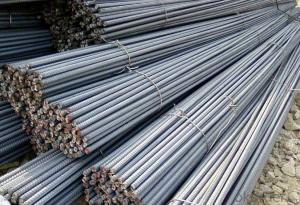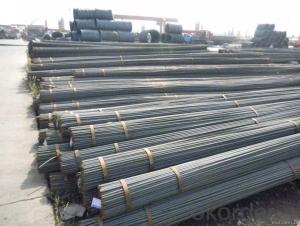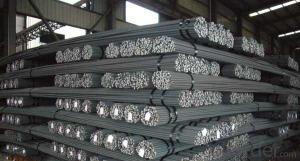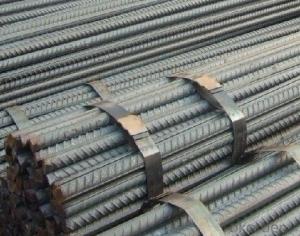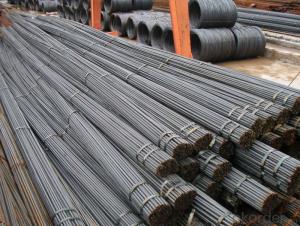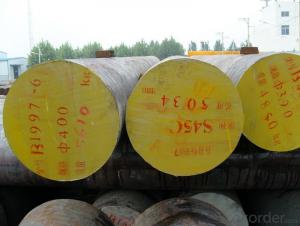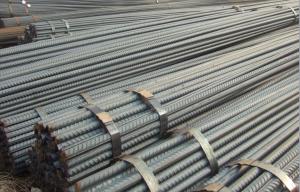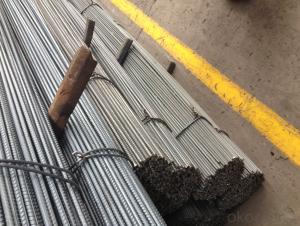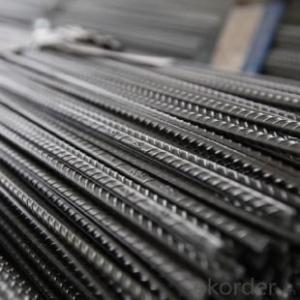Deformed steel bar 6-40 MM HRB 400 HRB 500
- Loading Port:
- Qingdao
- Payment Terms:
- TT OR LC
- Min Order Qty:
- 600 m.t.
- Supply Capability:
- 19452 m.t./month
OKorder Service Pledge
OKorder Financial Service
You Might Also Like
Specification
Rebar is common steel reinforcing bar, an important component of reinforced concrete and reinforced masonry structures.
It is usually formed from mild steel, and is given ridges for better frictional adhesion to the concrete.
To prevent such a failure, rebar is either deeply embedded into adjacent structural members, or bent and hooked at the ends
to lock it around the concrete and other rebars. This first approach increases the friction locking the bar into place while the
second makes use of the high compressive strength of concrete.
Most grades of steel used in rebar cannot accept welding; such as, to adjacent steel plates or as means to bind single pieces
of rebar together. However, special grades of rebar steel and welding rods make welding by expert welders possible.
Our Advantage:
High quality steel products from 1 class mills in China
Reasonable price
Professionalism of the products
On-time delivery
Complete documents and certificates
Sincere service to meet our clients' requirements
Product Description :
Chemical composition (%): | Steel | C | Si | Mn | P | S | Ceq | ||||
HRB335 |
0.25 |
0.80 |
1.60 |
0.045 |
0.045 | 0.52 | |||||
HRB400 | 0.54 | ||||||||||
HRB500 | 0.55 | ||||||||||
Mechanical properties | Steel | Rel/ MPa | Rm/ MPa | A/ % | Agt/ % | ||||||
≥ | |||||||||||
HRB335 | 335 | 455 | 17 |
7.5 | |||||||
HRB400 | 400 | 540 | 16 | ||||||||
HRB500 | 500 | 630 | 15 | ||||||||
Package: | Standard export packing or as customer's request | ||||||||||
Application: | Construction, building, bridge, road. ect | ||||||||||
Payment terms | 1).100% irrevocable L/C at sight. | ||||||||||
Delivery time | 15-30 days after receipt of L/C or deposit by T/T | ||||||||||
Features
1、Pure steel quality, stable chemical contents, small tolerance.
2、Constant Quality, good drawing performance.
3、High dimension accuracy degree, accuracy degree of Level C up to 80%, smooth surface, less scale, easy to be pickled.
4、Automatic bundling with 4 lines by Machine in tidy and good looks
5、Big high quality percentage, small coil percentage, and heavy coil weight for Hard Coil.
6、High sorbitizing percentage.
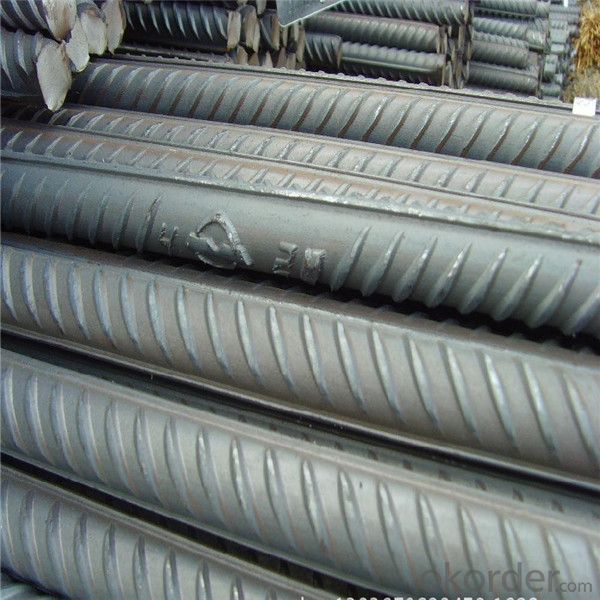
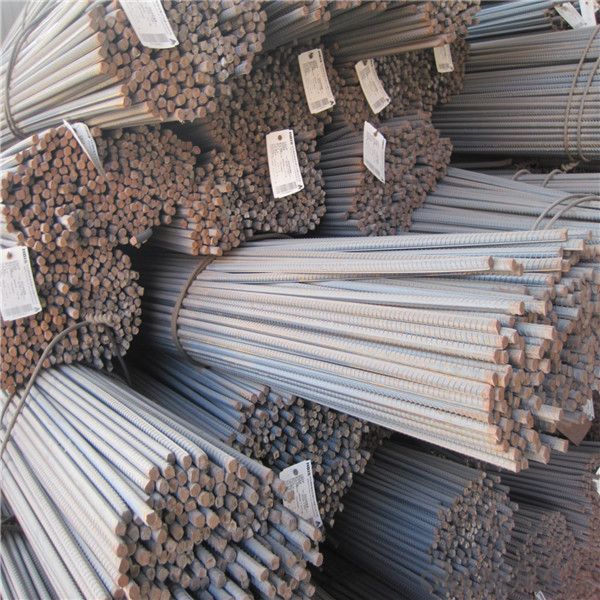
Packing:
In bundles, each bundle weight 3.5 tons. Load by container or by bulk verssel.
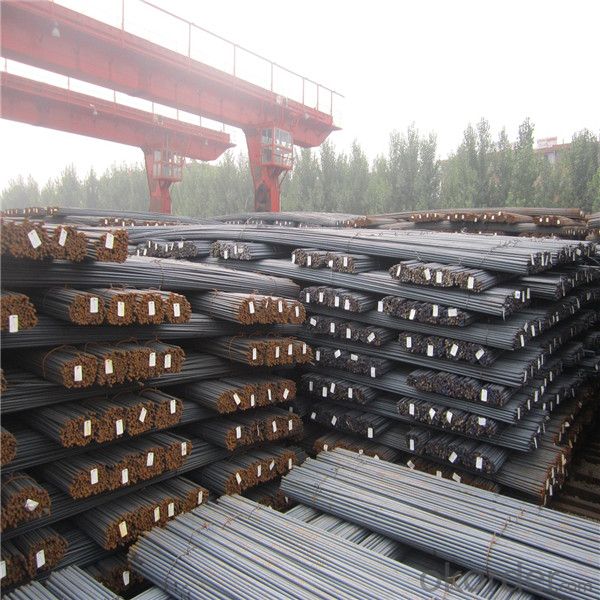
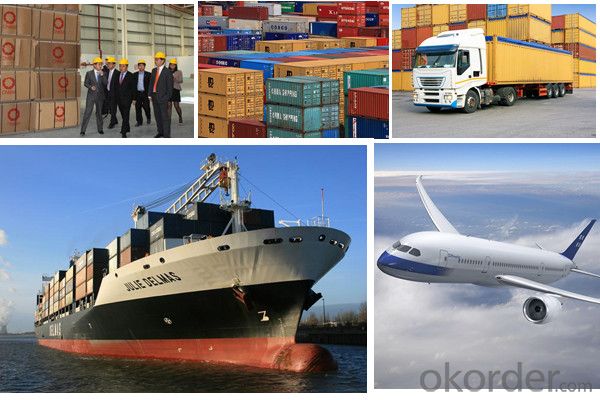
Our service
(1) We cooperate with famous factories with advanced equipment and well trained workers.
(2) We can provide factory price with trading company service.
(3) We continuously work on the improvement of our processes, guaranteeing consistently high standards
of quality to keep none compensation.
(4) We guarantee 24 hours response and 48 hours solution providing service.
(5) We accept small order quantity before formal cooperation.
(6) We deliver the agreed quality at the agreed time, reacting to changes in customer wishes in a flexible way.
(7) Due to our volume and selling power, we have excellent freight rates with shipping lines.
(8) We strive to always be fair and honest in our dealings with customers.
(9) We strive to work together with customers to achieve much more than we can achieve alone.
(10) Through our passion and commitment we aim to be a market leader in all our key markets. To maintain
our position as market leader we must continue to add value in all that we do.
FAQ:
1.Q: What's your MOQ(minimum order quantity)?
A: One full container, mixed acceptable .
2. Q: What's your packing methods?
A: Packed in bundle or bulk ..
3. Q: How can I buy CNBM products in my country?
A:Please send us an inquiry or email ,we will reply to you if there is distributor in your country
4. Q: Can we visit your factory?
A: Warmly welcome. Once we have your schedule, we will arrange the professional sales team to follow up your case.
5. Q: How long does it take to get the product if i place an order?
A:With the process of your requirements,we will pack and deliver in 3-7 days. If it is by sea shipment,it will take 15-45 days depending on different locations
- Q: Are there any health or safety concerns associated with steel rebars?
- Yes, there are potential health and safety concerns associated with steel rebars. Some of the concerns include physical injuries from handling and working with heavy steel bars, such as cuts, bruises, and strains. Additionally, exposure to steel dust or fumes during cutting, welding, or grinding processes can pose respiratory hazards. It is important to follow proper safety protocols, such as wearing personal protective equipment, ensuring proper ventilation, and using appropriate tools, to minimize these risks.
- Q: What is the process of pre-stressing steel rebars?
- The process of pre-stressing steel rebars involves applying a predetermined amount of stress or force to the rebars before they are subjected to loading. This technique is commonly used in the construction industry to improve the structural strength and durability of concrete structures. The process typically starts with the selection of high-strength steel rebars that have good tensile strength properties. These rebars are usually made from carbon steel or alloy steel and come in various sizes and shapes, depending on the specific application. Once the rebars are selected, they are cleaned and coated with a protective layer to prevent corrosion. After that, the rebars are placed into the desired position within the concrete structure, such as beams, columns, or slabs, according to the design specifications. Next, the pre-stressing process begins. There are two primary methods for pre-stressing steel rebars: pre-tensioning and post-tensioning. In pre-tensioning, the rebars are initially tensioned by fixing them to an anchorage point or a strong frame. The opposite end of the rebars is then pulled using hydraulic jacks or mechanical devices, applying a significant amount of force. Once the desired stress is achieved, the rebars are secured in their stressed position by casting concrete around them. After the concrete has hardened, the jacks or devices are released, transferring the stress to the rebars. In post-tensioning, the rebars are first placed into the concrete structure without any initial tension. After the concrete has hardened, a series of ducts or channels are created within the structure, running along the path of the rebars. High-strength steel strands or cables are then inserted through these ducts. The strands are anchored at one end of the structure and tensioned using hydraulic jacks or similar devices. This tensioning process applies a force to the rebars, which is transferred to the concrete, compressing it. Once the desired stress is achieved, the strands are secured and the ducts are filled with grout or mortar to protect them from corrosion. Both pre-tensioning and post-tensioning techniques result in pre-stressed steel rebars that provide several benefits to concrete structures. These include increased load-carrying capacity, improved resistance to cracking and deformation, enhanced durability, and overall better structural performance. The process of pre-stressing steel rebars is a vital aspect of modern construction practices, ensuring the longevity and safety of various types of concrete structures.
- Q: What are the common mistakes to avoid when installing steel rebars?
- To ensure a successful and safe installation of steel rebars, it is important to avoid several common mistakes: 1. Placing the rebars incorrectly is a frequent error that must be avoided. Accurate placement should be carried out in accordance with the engineering or construction drawings. Any deviation from the specified location can compromise the structural integrity of the reinforced concrete. 2. Insufficient concrete cover over the rebars is another mistake to avoid. The cover acts as a protective layer, preventing corrosion and providing fire resistance. Inadequate cover can lead to premature deterioration and structural failure over time. 3. Proper support for the rebars is crucial during the concrete pouring process. Insufficient support can cause sagging or movement of the rebars, resulting in an uneven distribution of steel reinforcement and compromising the structural strength of the concrete. 4. Correct alignment and spacing of the rebars according to design specifications is essential. Improper alignment can lead to congestion, difficulties in pouring concrete, and compromised bond strength between the rebar and concrete. Similarly, incorrect spacing can result in insufficient reinforcement, reducing the overall strength of the structure. 5. Thoroughly cleaning the rebars before installation is necessary to remove rust, dirt, and other contaminants. Failure to do so can lead to poor bond strength and an increased risk of corrosion, weakening the structure over time. 6. Adequate tying of the rebars using the appropriate wire or connectors is essential to maintain alignment and ensure the structural integrity of the reinforced concrete. Neglecting proper tying can result in shifting or movement during the concrete pouring process, compromising the structural strength. 7. Lack of supervision and quality control during the installation process is a common mistake. Experienced personnel should oversee the installation to ensure compliance with design specifications, proper installation techniques, and adherence to safety guidelines. By avoiding these common mistakes, the installation of steel rebars can be carried out effectively, resulting in a strong, durable, and safe reinforced concrete structure.
- Q: What are the environmental benefits of using steel rebars?
- Using steel rebars in construction projects has several environmental benefits. Firstly, steel is a highly recyclable material, which means that steel rebars can be reused or repurposed after their initial use. This reduces the demand for new steel production and decreases the amount of waste sent to landfills. Additionally, steel rebars have a longer lifespan compared to other construction materials, such as wood or concrete. This durability reduces the need for frequent replacements and repairs, thus reducing the environmental impact associated with production and transportation of new materials. Steel rebars also offer superior strength and stability, leading to more resilient structures. This helps in reducing the risk of structural failures or collapses, which can have devastating environmental consequences. By using steel rebars, the overall safety and longevity of buildings and infrastructure are enhanced, reducing the need for extensive reconstruction or demolition in the future. Furthermore, steel rebars are resistant to corrosion, which means that they require less maintenance and upkeep over time. This reduces the use of chemicals and resources typically needed for maintenance purposes, resulting in lower environmental impact. Lastly, steel rebars can be manufactured with a high percentage of recycled content. By utilizing recycled steel, the demand for new steel extraction and the associated environmental impacts, such as deforestation and habitat destruction, can be reduced. Overall, the use of steel rebars in construction projects offers several environmental benefits, including reduced waste generation, increased durability, enhanced structural safety, lower maintenance requirements, and decreased reliance on new steel production.
- Q: Can steel rebars be used in structures with high levels of carbonation or acid attack?
- Steel rebars should not be used in structures with high levels of carbonation or acid attack. Carbonation occurs when carbon dioxide from the atmosphere reacts with the alkaline compounds in concrete, resulting in the reduction of the concrete's pH level. This process can lead to the corrosion of steel rebars, as the lower pH levels create an acidic environment that promotes rusting. Similarly, acid attack occurs when structures come into contact with acidic substances, such as industrial chemicals or acid rain. Acidic environments accelerate the corrosion process by further reducing the pH levels of the concrete, increasing the risk of steel rebar deterioration. To prevent these issues, alternative materials like stainless steel, epoxy-coated rebars, or fiber-reinforced polymer rebars can be used in structures exposed to high levels of carbonation or acid attack. These materials have enhanced corrosion resistance properties, providing better durability in challenging environments. It is crucial to consider the specific conditions in which the structure will be exposed and consult with structural engineers to select the most suitable materials for long-term performance and safety.
- Q: How are steel rebars used in the construction of power transmission towers?
- To reinforce and strengthen power transmission towers, steel rebars are commonly utilized in their construction. These rebars, typically crafted from high-strength steel, find application in various tower components such as the foundation, columns, and cross arms. To bolster the load-bearing capacity of the foundation, steel rebars are embedded in concrete. By distributing the weight of the tower and transmission lines, these rebars maintain the stability of the foundation and enable it to endure the exerted forces. Within the tower columns, steel rebars are employed to fortify the concrete structure, enhancing its strength and stability. Given that power transmission towers are often exposed to strong winds, seismic activities, and other external forces, the presence of rebars prevents the concrete from experiencing cracks or collapses. This ensures the tower's integrity and longevity. Additionally, steel rebars are utilized in the construction of cross arms, which provide horizontal support to the transmission lines. By reinforcing the cross arms, these rebars enable them to effectively bear the weight of the lines. This is particularly crucial since power transmission lines can span long distances and carry significant loads. To summarize, the utilization of steel rebars is crucial in the construction of power transmission towers as they provide the necessary strength and reinforcement to ensure the tower's stability and durability. The absence of these rebars would render the towers more vulnerable to structural failures, posing risks to the transmission lines and surrounding areas.
- Q: What is the difference between three - grade steel and other grades?
- 1, different grades of steel (chemical composition is different). HRB335 grade steel is 20MnSi (20 manganese silicon); HRB400 grade steel bars are 20MnSiV or 20MnSiNb or 20MnTi etc.;2, strength is different, HRB335 grade steel tensile and compressive design strength is 300MPa, HRB400 grade steel tensile and compressive design strength is 360MPa.
- Q: Can steel rebars be used in structures with limited foundation support?
- Yes, steel rebars can be used in structures with limited foundation support. Steel rebars are commonly used as reinforcement in concrete structures to enhance their strength and durability. They can help distribute the load more evenly across the structure, which can be particularly beneficial in situations where there is limited foundation support. However, it is important to assess the specific circumstances and consult with a structural engineer to ensure that the design and placement of the rebars are appropriate for the given foundation conditions.
- Q: How do steel rebars prevent cracks in concrete?
- The reinforcement provided by steel rebars is essential for preventing cracks in concrete. These rebars increase the tensile strength of the concrete, which is weak in tension. While concrete can withstand compressive forces, it is susceptible to cracking when subjected to tension or pulling forces. When steel rebars are embedded in concrete, they function as a framework or skeleton that distributes the tensile forces evenly throughout the structure. As a result, the rebars absorb the tension, effectively preventing the concrete from cracking or failing under the applied load. In addition to absorbing tension, the rebars also control the size and width of any cracks that may occur. By confining the cracks to a limited area surrounding the rebars, they prevent the cracks from spreading throughout the entire concrete structure. Furthermore, the presence of rebars can even help prevent cracks from forming in the first place, as they reinforce the concrete and improve its overall durability. To summarize, steel rebars play a critical role in preventing cracks in concrete by increasing its tensile strength, absorbing tension, and controlling crack propagation. This reinforcement is vital in ensuring the structural integrity and longevity of concrete structures, effectively preventing potential failures and ensuring their safety.
- Q: How do steel rebars affect the overall fire safety of a structure?
- Steel rebars can significantly enhance the fire safety of a structure. Due to their high melting point and excellent heat conductivity, steel rebars act as reinforcements that help maintain the structural integrity of a building during a fire. They prevent the concrete from cracking and collapsing prematurely, allowing occupants more time to evacuate safely. Additionally, steel rebars can also facilitate the distribution of heat, reducing the risk of localized hotspots and minimizing the potential for structural failure.
Send your message to us
Deformed steel bar 6-40 MM HRB 400 HRB 500
- Loading Port:
- Qingdao
- Payment Terms:
- TT OR LC
- Min Order Qty:
- 600 m.t.
- Supply Capability:
- 19452 m.t./month
OKorder Service Pledge
OKorder Financial Service
Similar products
Hot products
Hot Searches
Related keywords
